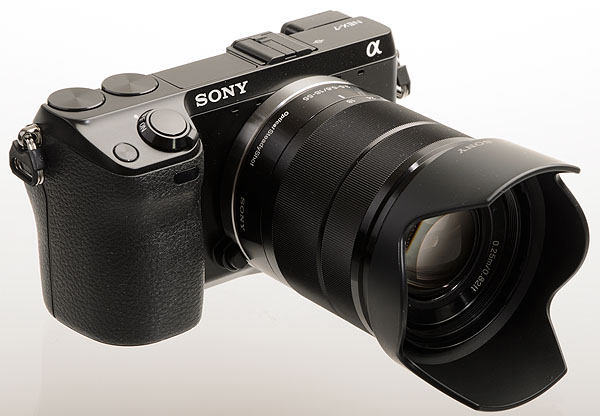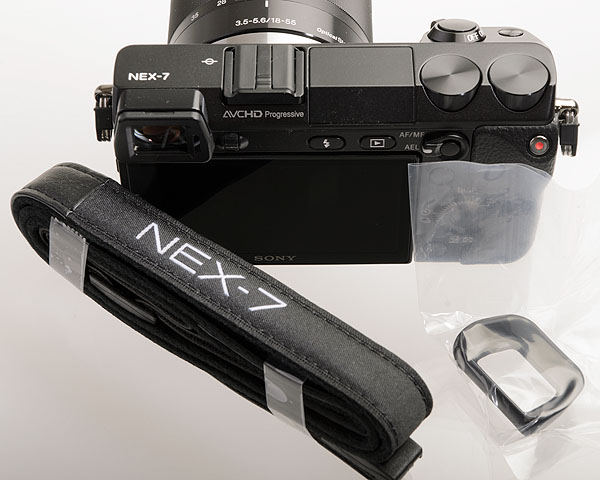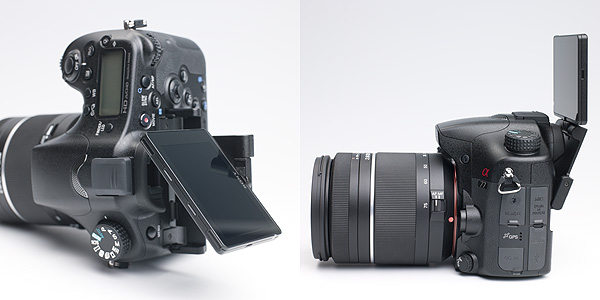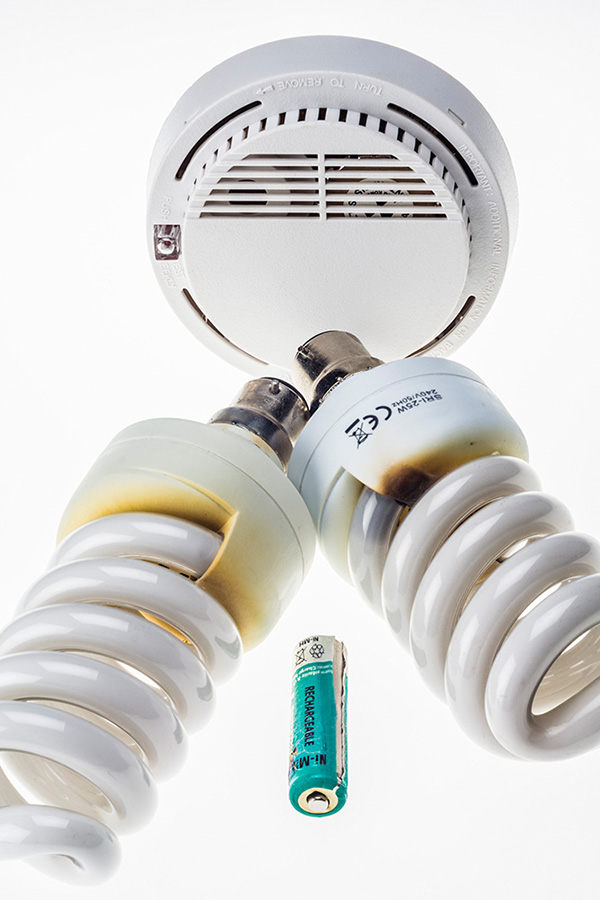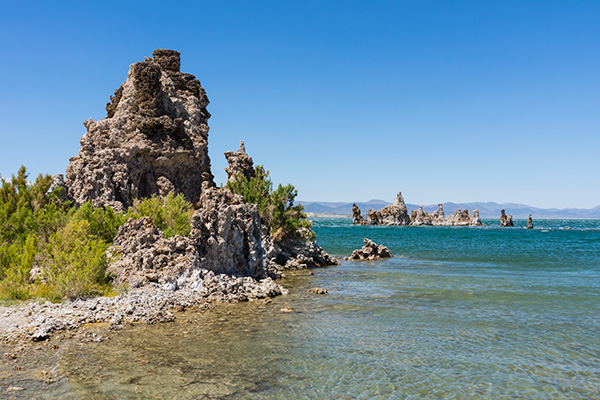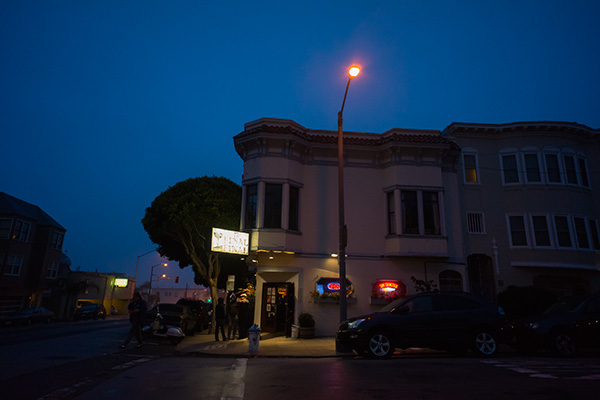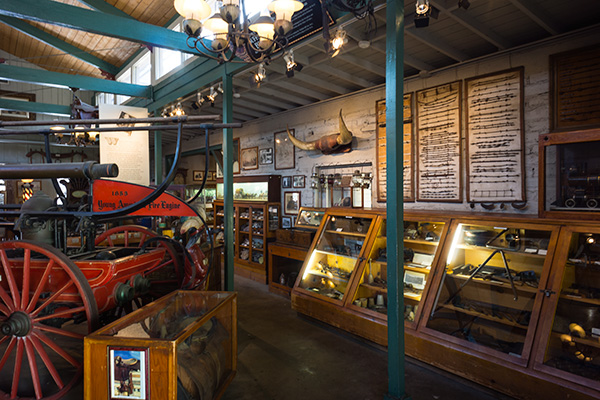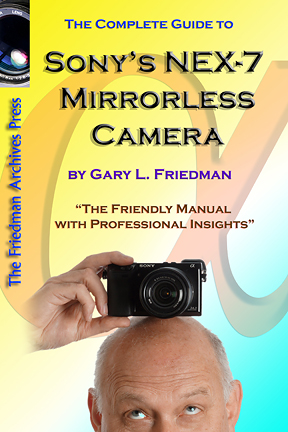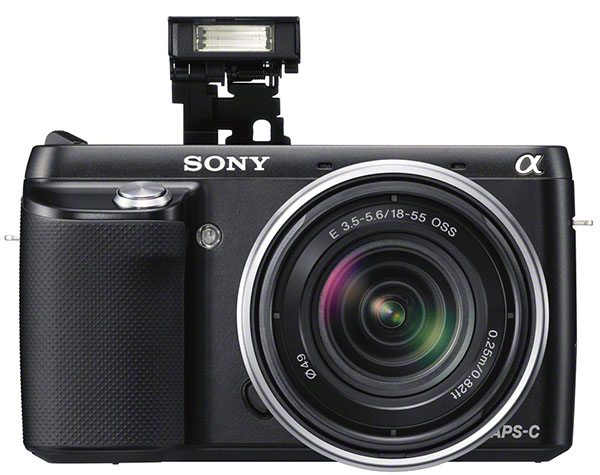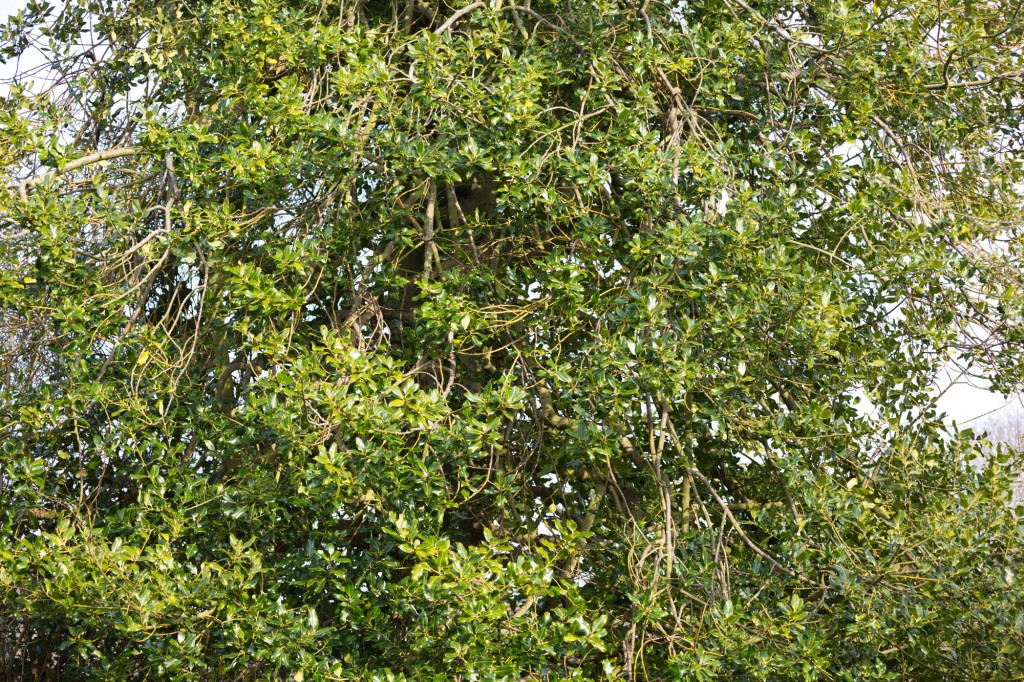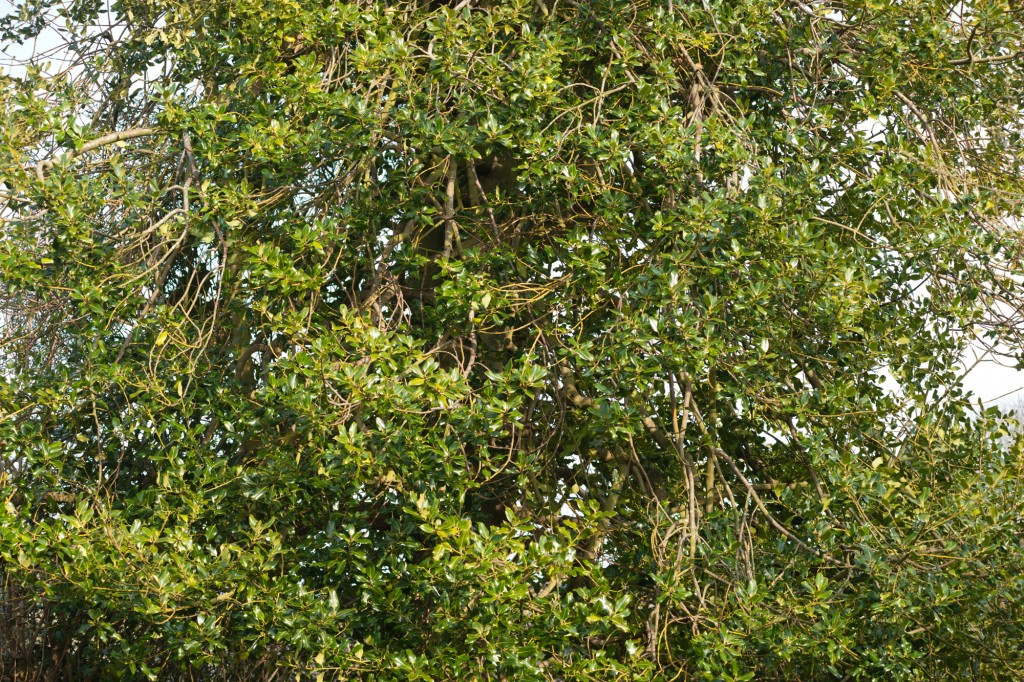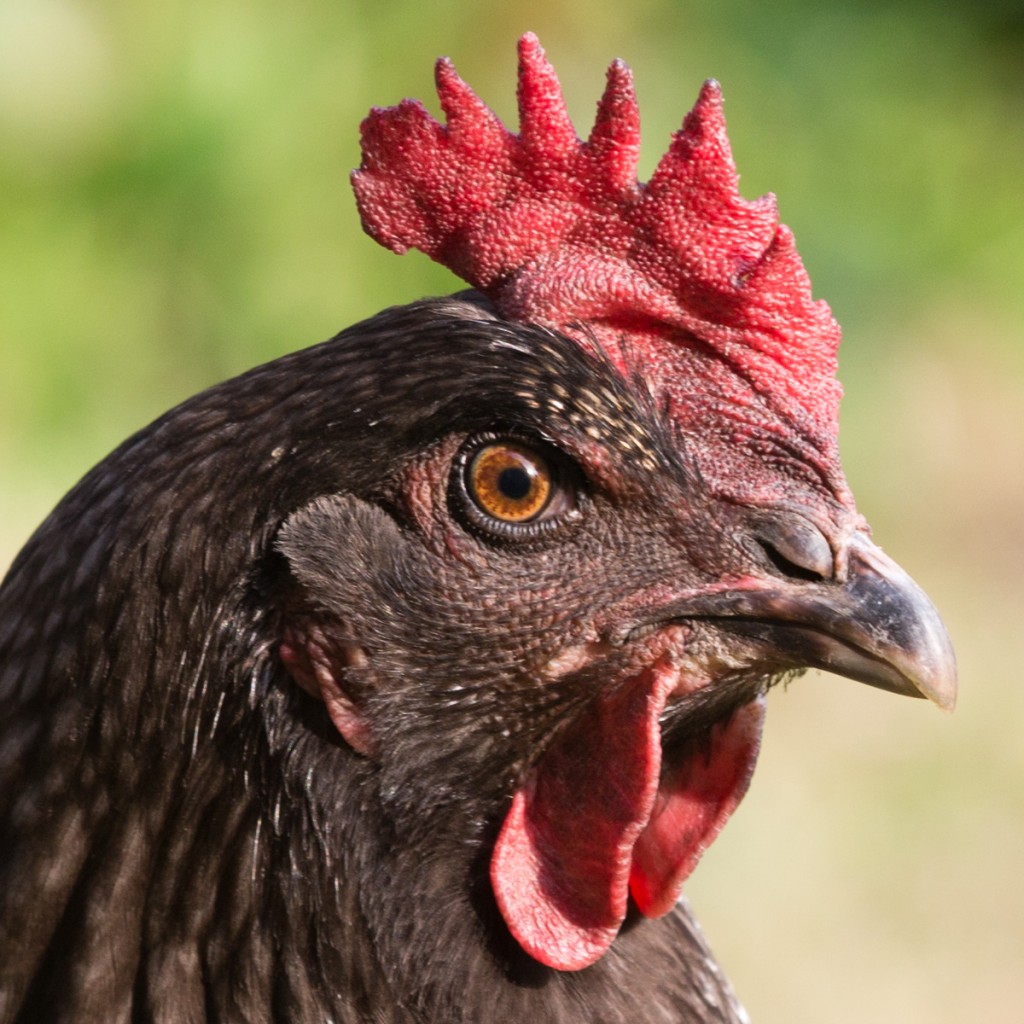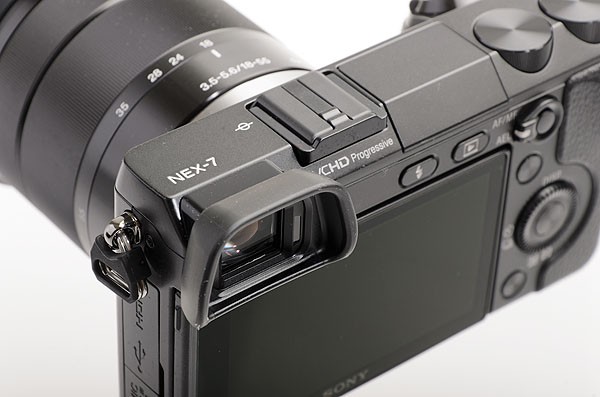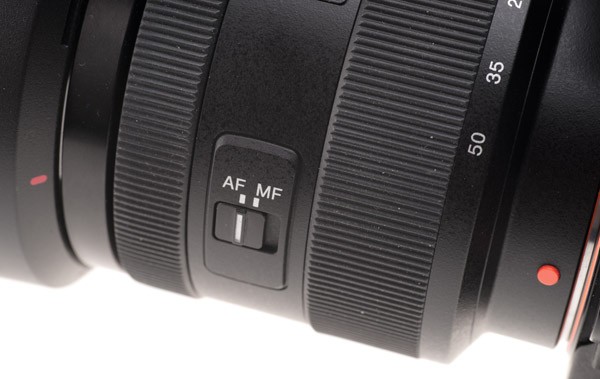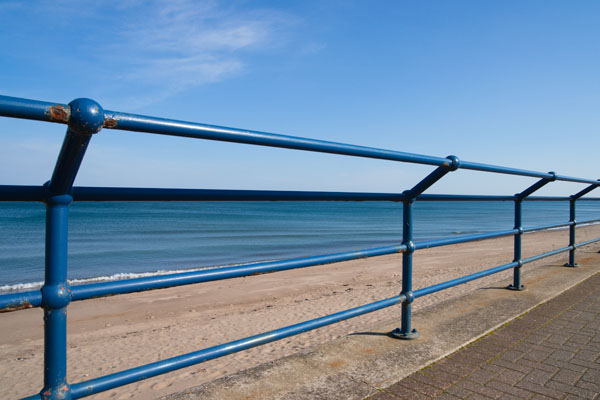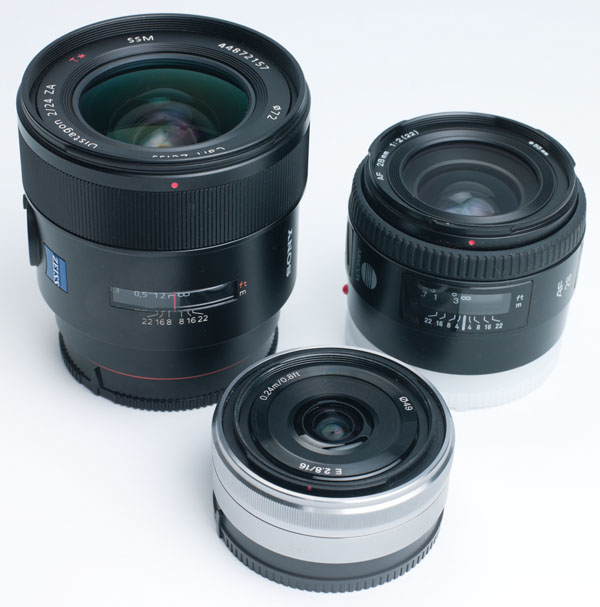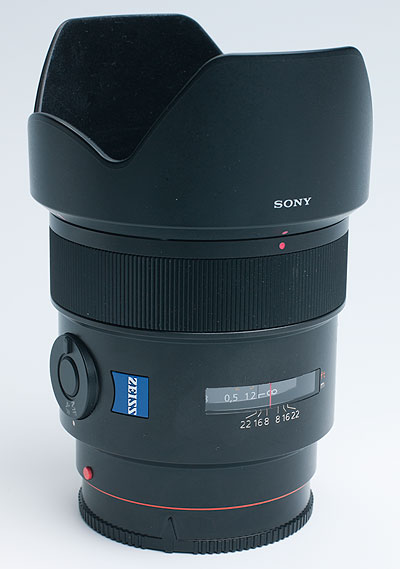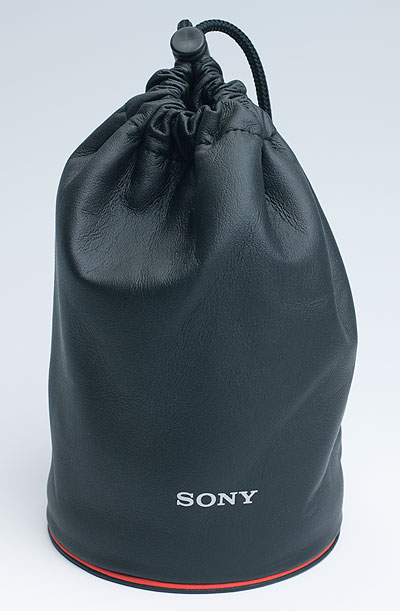Sony NEX-7: the high-end hybrid
The Sony NEX-7 is not a NEX at heart. It’s part of the rest of the Alpha system in every respect except its lens mount, and even that can be converted with a choice of two adaptors. A NEX-7 with an LA-EA2 phase detection autofocus adaptor is little different from an Alpha 65.
The NEX-7 does not accept any of the smart accessory terminal add-ons common to the NEX-3 and NEX-5 models, because it lacks the accessory slot. That means it does not use the same flash models, or the same microphones. Instead the NEX-7 has the iISO Minolta flash shoe, accepts all the flash accessories from the Alpha range and is capable of wireless remote flash operation.
Its external microphone, if required, is also from the Alpha system or any suitable 3.5mm stereo jack connected model mounted on a bracket or an accessory shoe adaptor.
Packaging sequence
Click this for an enlarged view of the opened box, which was full of white bits. Though sealed and brand new, the NEX-7 purchased needed a good dusting and blowing before removing its front cap and fitting the lens.
You can’t see here, but when the cap was removed from the body there were specks of the same white packaging filler on the matt black baffle between the lens mount and the sensor. But, once blown clean, the NEX-7 proved remarkably free from dust-on-sensor problems. It’s one of the least dust-prone cameras I have ever used, despite the exposed position of the sensor which is not even covered when lenses are changed or when the camera is turned off.
The dust on the camera may also be seen here. The eyepiece surround is supplied separately packed and sealed. It is not soft rubber, and makes pretty sharp contract with my brow, almost demanding to be shoved into my eye like an eyecup, with specs removed. I found the finder good to use but started removing my glasses permanently when working with the 7 outdoors.
Battery and stamina
Given the relatively short battery life of any camera using an EVF as sophisticated as the Sony OLED device, I feel it’s a pity they did not go the whole distance and have a larger right-hand grip housing the 500-series lith-ion used by the 77, 900, 700, 5xx and other larger more ‘professional’ camera bodies. The little 1050mAh 50-series cell shared with the lesser Alpha 55, 33 and all NEX models is stretched to the limit by a 24 megapixel EVF camera. Third party 1300mAh versions don’t actually seem to last any longer.
What’s interesting is that losing the flapping mirror and mechanical focus and aperture operation, found in the earlier Alphas, has not doubled battery life. You would imagine all this heavy mechanical stuff would drain power fast, but in fact the electronic alternative of live view, with the sensor active all the time feeding a digital viewfinder, proves far less efficient.
Because the NEX-7 uses an external power option with a dummy battery (a Canon approach I have never much liked, always preferring dedicated DC input) it would be possible to design an add-on base with a better power source. But as with other NEX models, the SD card slot lives in the battery compartment and such a ‘power grip’ would either need to be removed to change cards, or incorporate more adaptation to provide a relayed memory slot.
Despite its odd position between the Alpha and NEX ‘systems’ and the clear drawbacks of some aspects of its design, the NEX-7 is a compelling camera. It’s got some of the handling qualities of a classic screw-thread Leica, from the left-hand eye position to its overall dimensions and a reassuringly solid feel. It does not surprise me that so many owners enjoy fitting Leica lenses of all eras; they look correctly proportioned, and in the case of late designs for the CL/CLE they were designed to fit a body which may even have inspired the 7.
Missing the point
The hammering taken by the little battery probably accounts for why no GPS was built in to the 7. This must have caused many buyers and owners much frustration, especially if their previous camera or other camera happens to be an Alpha 55, 65 or 77. The NEX-7 can make these redundant for travel and landscape work, but those are exactly the times you want GPS. The NEX-7 is not so much use in the studio, or for action sports, or domestic shots… the times when you do not need GPS!
This is the one mismatch in the specifications which has caused me problems in making decisions about what to use when, and when gear to keep for the future. It has left me unable to part with other cameras despite the fact that I don’t really need them; and it leaves me obliged to take my A55 or A77, instead of the NEX-7, on expeditions where the NEX-7 might be more convenient. In the end it is what has persuaded me to part with the NEX-7; I have ended up using the Alpha 77 all the time instead.
The other omission in the NEX-7 is in-body stabilisation, not just sensor-movement but the pixel-tracking electronic variant used only for video in the A65/77. This prevents the 7 from being a true alternative to the larger DSLR/SLT models even when the LA-EA2 adaptor is fitted, unless you are very lucky and can find a compatible Sigma OS lens from the period before Sigma decided to drop optical stabilisation from Alpha mount products. It also limits its use with many manual classic lenses.
What you do get is a bigger sensor area used for HD video than on the 77 or 65. It’s interesting that this was possible, as video readout can demand a limited choice of source pixel dimensions for best quality. With a bigger source frame, perhaps the NEX produces better video, but it’s not a difference I can detect.
It would be wonderful if it turned out that the processor and firmware of the NEX-7 allowed Sony to issue an upgrade to add pixel-tracking electronic stabilisation (even with the inevitable crop of video to 1.87X factor). Is there any reason why pixel-tracking can not be used instead of sensor shift for stills? Others are using it. It certainly can work for viewfinder stabilisation with an EVF, as it does with the A77.
Great features of the NEX-7 – that ‘real’ hot shoe, the pop-up flash, the twin control drums, and the EVF – are let down by lack of GPS and video stabilisation for manual lenses, both offered by Alpha SLT models.
Cynics will believe that Sony could have implemented all this, but preferred to limit the NEX-7 and avoid cannibalising Alpha SLT sales. I think they simply didn’t think it through, or realise how the NEX-7 would change the profile of the whole NEX system to the point where some photographers could consider using nothing else. And they may have needed to use the processor power in other ways.
The killer button
While the first reaction to NEX-7 design tends to be delight at the provision of two unmarked, identical control wheels on the top right rear edge the new owner quickly discovers there is one tiny button which changes the reliability and usefulness of the camera beyond all else.
Seen here with the pop-up flash raised, showing also the infra-red remote front facing sensor and the on-off switch surrounding the shutter release, is that very important small unlabelled flat button.
That is the flat black button to the right of the shutter release, unlabelled. You could assume that its ability to invoke a series of the most useful screen menus, to change key settings in a manner close to Sony’s Alpha 700 QuickNavi, would be most praised.
But no. It is the ability of this button to LOCK the camera setting controls – to disable operation of the TriNavi control wheels (rear multi-way optional, and two top as a minimum). Just hold the button down for two seconds, and a message appears saying the settings are locked. That means that if you have set Aperture Priority, f/9, ISO 200, no exposure over-ride then the camera will stay that way until you unlock it and change things. That just needs another two-second pressure, something you are not likely to do by mistake.
The handy tips are not optional (more detailed ones are). The rear screen is bright and very sharp. I fitted a GGS-type glass screen surface shortly after the product shots were taken. That movie record button is a bit of an issue, see later comments.
You do get continued access to the exposure over-ride and ISO change even when the controls are locked, but only with enough deliberate action to prevent your clothing or your camera bag from doing what it does so well on the NEX-5n – setting several stops of underexposure. It rarely goes the other way for me. I’ve had this happen between two shots without apparently touching the camera! The rear controller which handles this function is so light in its action, and indeed the dials of the NEX-7 are equally free.
This single point about the NEX-7 puts it ahead of the NEX-5n and all earlier NEX models for me, despite the fact that NEX-5n images are often better in low light, and all previous NEX sensors seem to produce rather smoother sky noise at minimum ISO.
What it does not lock is the other killer button – the movie shoot red button, placed to catch your thumb or the camera strap or anything else passing. It is ridiculously easy to start shooting video accidentally; it happens often enough on all NEX models, but the 7 takes it to a new extreme. It needs to be included in the LOCK function with the next firmware update, or its operation changed to a two-press action; first press changes to movie mode and crops the finder view, second press starts filming; half pressure on shutter release when in pre-shoot mode returns immediately to stills mode.
It’s surprisingly difficult to hit the movie the button with the camera at your eye when you want to. For a button which is so easy to hit by mistake, it scores top marks for being hard to find when you need it.
The AVCHD-2 file structure makes the situation worse, by putting the camera into video directory mode if you accidentally record a second or two of video. If you don’t immediately hit the delete button and remove this, but instead start shooting stills, it is a bit tedious to get back into the video playback mode and delete the unwanted clip. The fastest way to get there is to shoot another brief instant of video, then playback and delete this and your previous accidental clip; menu diving to change between still and movie playback takes much longer.
Hitting the movie button to shoot short clips, like these taking using the 18-55mm OSS lens and high quality 1080p, is not always easy as you must move your secure firm thumb-position on the grip to press it.
This is a failing of the dual directory structure, which maintains an entirely separate ‘database’ for AVCHD movies, preventing you ever playing back mixed stills and video or accessing both at the same time for file management (delete!) purposes.
While the Lock/Unlock function does improve the handling of the camera, it has mysterious lapses. I’m still trying to work out exactly when and how my ISO setting is changed on a locked camera, nearly always to something unreasonably high. It doesn’t happen often but when it does, it frequently manages to be the next frame after one shot I have taken normally, and done nothing more than drop the camera from my eye and lift it again.
The sensor dilemma
ISO 1600, natural light, handheld – no noise reduction at all when processed from raw using Adobe Camera Raw. A full size version can be downloaded by photoclubalpha subscribers.
The same with 25/50 noise reduction for both luminance and colour settings in ACR. A full size version of this is also available to members.
This brings me to the question of the 24 megapixel sensor. As with the Alpha 77, it only provides true advantages when used at or close to its lowest ISO setting. On the NEX-7 this is 100 not 50, and the overall performance of the NEX is ahead of the SLT design through the range of ISO up to 16,000 maximum. It’s not a doubling of speed for the same noise level, more a matter of getting slightly better images at the same setting. However, using the Alpha 77 ISO 50 setting puts it ahead of the NEX in practice.
The strength of any AA filter is determined by two factors, its diffracting or diffusing power, and the gap between the filter and the sensor. If you increase the gap, the strength of the filter must be reduced; put it very close to the sensor surface, and a strong filter is needed.
Today’s designers prefer a weaker filter and a larger gap, as this reduces the effect of dust on the filter, a major cause of user dissatisfaction. Anyone who has used a camera such as the Canon 5D MkII which has a very weak AA filter very close to the silicon will know the problem, but that camera takes the effect so far you can often see moiré patterns too. The AA filter is too weak, and video makers often get the camera customised expensively, replacing the front glasses over the sensor with a stronger low-pass.
A second effect of a filter closer to the sensor is that at the corners, the stronger diffraction structure may be further strengthened by the angle of the rays passing through. The distance from filter to sensel is greater with rays at an acute angle than those passing through on axis.
The strength and distance of the filter are also linked to the density of the sensels on the sensor (pixel pitch). The 16 megapixel of the NEX-5n and 24 megapixel sensors of the NEX-7 have subtly different AA filter assemblies. This leads to some lenses performing better on the 5n, some on the 7. Whatever the complex mix of underlying reasons, there are many who would love to see the robust and versatile 16 megapixel sensor find its way into a NEX-7 body because they want to use third-party manual lenses such as the Voigtlander 12mm or 15mm Leica mount designs.
From my point of view, I like the 7. It seems to have a weaker filter and maybe a greater gap between glass and silicon, if the dust-on-sensor results are anything to judge by. I have not noticed any serious colour shift with, for example, the 16mm pancake lens but my experience with the lens is so different from many others. I rate it as one of the better f/2.8 85° angle lenses around, not the “it sucks” offering often implied.
Even after downsizing and crunching for the web, the moiré on the flyscreen of this diner on the run up to the Mojave desert can be seen. If you are a photoworld member you can access a full size, level 12, AdobeRGB version without sharpening or NR and see just how well the 16mm has performed at f/10, a sensible working aperture.
NEX or Alpha?
Apart from issues of stabilisation and GPS, the choice between NEX-7 and the similarly priced Alpha 77 involves a few other considerations.
First of all, there’s weatherproofing or ruggedness. The 77 is a very tough, splash or rainproof camera with a ‘skinned’ body, externally finished to be fairly resistant to minor scuffs. The NEX is a bare metal body without any special attention to dust or moisture proofing.
Then, there’s the duty cycle. The NEX has the familiar basic 1/4000th shutter, admittedly with the electronic front curtain option that doubles its expected life if you use it all the time. The 77 has exactly the same option but based on the 1/8000th shutter only found in top-end Alphas 700, 850 and 900. That gives it probably the longest expectation of shutter life yet in any Alpha, time will tell.
There are a not many functions on the 77 not found on the NEX, but there’s one big physical difference – the rear screen.
Inarticulate viewing
The NEX-7, a major redesign compared to the 3 and 5 series, sticks to exactly the same rear screen frame and hinge setup as those with a minor adjustment to angles and a slightly tougher construction. This is not one of the best design decisions made by Sony, and has drawn some users to other makes.
The articulated screen of the Alpha 77 is not just good for viewing portrait compositions at waist-level or aiming ahead to see yourself when doing a self-timer group or making a video ‘to camera’. It is good for not using at all! Nearly all the time, when not wanted for a specific purpose, the screen of my Alpha 77 stays reversed to the camera. It feels more comfortable, it never lights up when working indoors or draws attention because of its glow, it does not get marked by my hands or face. Same goes for my older 55.
The NEX-7 screen, in contrast, is permanently exposed and also limited in its movement. It is not good for vertical compositions, and it can’t be used for viewing from the front. It also can not be protected by facing towards the camera.
How different the 7 would be, had the screen been designed like the Alpha 77! It would have felt like a pure rangefinder camera with the screen reversed and I’ve considered getting or making some kind of cover just to hide it away. The surface of the NEX-7 screen is very easily marked, and I picked up a single visible scratch line on it within a week. A month later I finally obtained a GGS MkII type glass screen protector (the model labelled NEX-5C is correct) and felt able to use the NEX freely in the real world, instead of treating it as a fragile object.
I use the angled screen occasionally on the NEX-7 or 5n, but don’t use the angled viewfinder of the NEX-5n with accessory EVF. Most times I need an angled screen, it’s because I want to hold the camera overhead, at ground level or at waist level. Not up to my eye.
There is one button press which doesn’t exist on the NEX series, but exists on all the SLT models – switch between EVF and rear screen. With auto switching set, the EVF takes over when you raise the camera to your eye, but the rear screen continues to operate after the camera is returned to strap-hung position. The only way to prevent it from continuing to operate is to use the power save delay setting, and reduce this to the minimum ten seconds.
You can go into the menus, and switch the camera to use either the EVF only, or the LCD only. But there’s no over-ride if you do so. Set it EVF only, and the EVF is the only way to see the menus needed to get back to using the LCD. Set it to use LCD only and there is no quick way to use the EVF, you’ve got to menu dive.
There is not even an option which enables the LCD to cycle, through its display modes, to OFF. The closest I have got is to set the LCD for information display only and turn the brightness down to minimum manual. What I’d like to see is an EVF/LCD button, just as on the A77, because the NEX-7 is basically the same kind of camera. I don’t have to use that button on the A77 as I just reverse the screen, and flip it round when it’s needed.
Though there are many custom functions you can assign to buttons, EVF/LCD switch is not one of them. This may seem like nitpicking, but it is an omission that wastes battery power. Using the ten seconds power save timing still leaves the sensor and the display/s operating far too long. There is no state, unless you use the EVF only option, where the camera shuts off as soon as you take it away from your eye and take your finger off the shutter button.
I find it significant that without taking a single picture, while writing this section of the article only, checking the operation and changing menu settings the battery in my 7 has dropped from 33% to 17% power. The EVF uses more power than the LCD.
Shooting speed
Though the NEX-7 has a minimal shutter lag (20 milliseconds, or 1/50th) between pressing the shutter and achieving image capture, this figure is deceptive. The camera may not be ready to have the shutter pressed, indeed you may not even be able to see and compose your quickly-observed action shot before it is too late.
This may be why Sony has made the LCD/EVF aspect so restricting, and why the default settings use Auto switching and leave power on for 20 seconds before sleep. If you use these settings, the response of the EVF is much faster than it is when the EVF only is selected. The camera is already operating, feeding an image to the rear screen, and switches this image rapidly.
If you are already framing and viewing, shutter timing can be very precise. Indeed, with many subjects I’m so used to SLR-type delays I missed the moment by firing too soon – with the electronic first curtain, the camera sound happens AFTER the shot is taken, which is deceptive. But if you lift a sleeping 7 to the eye and expect to grab a street shot, you’ll be frustrated. It can take two, three seconds or more to get it alive, viewing, exposure set and focus happening. Bike and board action show at Knott’s Berry Farm, Tamron 18-200mm.
The slowest setup is to use the EVF only and set the image review to any time (it does not matter whether it’s for the minimum 2 seconds or longer). If you enable image review, you’ll be locked out for a second or so from taking another image in fast succession, and you’ll also see the image in the finder. This is a case where the functions of the EVF and the LCD need to be separated. The image review needs to be able appear on the LCD and never block the viewfinder or the shooting pipeline.
For fast shooting, disable image review entirely and leave the EVF/LCD set to auto with the power save mode set to longer than the gap between any two shots. I don’t think you should ever need longer than the 5 minute setting and for me one minute is enough. You can set up to an hour but I don’t see much point in this, unless you were waiting and watching unpredictable wildlife with the camera on a tripod.
Though the evidence is nothing more than observation, setting focus peaking may also very slightly delay shooting response, and using a single central focus spot actually seems slower than selecting the 25-point multi area AF (but that so often picks a foreground zone and misses your target).
When you get the NEX-7 set up correctly for maximum fast response and minimum possible interruption or delay, it’s a fast enough camera to use. Much also depends on the lens; the 16mm f/2.8 is almost instant in response, the 18-55mm OSS is hesitant, and the 18-200mm Tamron likes to wake up, stretch, yawn and then focus. Apparently the Sony 18-200mm behaves much the same way.
And then, what counts
OK, I’ve spent a lot of time looking at why a camera which could be nearly perfect falls just short, partly through small details of interface programming and default settings. Most reviews don’t even go into this stuff, apart from describing what can be found in the manual (which you don’t get in a physical form, only as a PDF on the supplied CD).
In practice, the NEX-7 produces stunningly good pictures at ISO settings under 400 and is definitely at its best with either 100 or 200 set. It is after all a high resolution camera, and in old-fashioned terms it is the Kodachrome 25 or the Pan F of the digital world.
A studio shot to show the hazards of electrical fires, with smoke detector. These are not contrived subjects, both ‘energy saving’ bulbs fizzled out this way (one hanging down vertically, the other upright in a large lamp) and the NiMH cell got hot enough to burn its covering and split it, in a charger. The NEX-7 at ISO 100, with a 50mm f/2 Russian tilt-lens, reveals a level of detail well beyond most full-frame DSLRs.
As we have found out repeatedly with DSLRs, there is little point in having expensive lenses and high resolution if the image is not correctly focused. The great strength of contrast-detect AF, and magnified assisted manual focus, is that both offer near-perfect focus regardless of aperture related shifts. You can check directly through the viewfinder by setting AF to DMF, which will automatically magnify the image if you touch the manual focus control of the lens after AF is confirmed.
The 24 megapixel sensor does not reward apertures smaller than f/11; I normally set f/8 or f/9 with the 16mm f/2.8 or 18-55mm, and use f/11 with the Tamron 18-200mm because the reduction in unsharpness towards the edges outweighs any loss of ultimate resolution.
The EVF serves perfectly well if you stick to the kind of subjects the NEX-7 is ideal for. While it has some great functions like Face Recognition including registering up to eight ‘known’ people, that sort of function is mainly for people who buy the 7 because it’s the best and looks the part. It is not really a great people camera despite the Smile Shutter and the convenient built-in flash. The NEX-5N is better because people tend to hang around in low light, indoors as well as out, in the evening as well as the day. The 5n has a near two-stop advantage in real terms for effortless high ISO quality.
Mono Lake, windy summer day; the NEX-7 is great for subjects like this at ISO 100. But so was the Box Brownie… and so is almost every camera made today.
Nor is any NEX model the ideal choice for pets, kids, school sports or the usual domestic stuff. It’s actually a better camera for creative still life, macro, architecture, landscape, fine art found studies, formal portraiture and of course top grade 1080/50-60p video. Unlike DSLRs (even SLTs) the 7 can focus very smoothly during video if the subject changes distance. No camera can be quieter in focusing or stabilisation.
If you do decide to stretch the NEX-7 to the limit, I’ve found that as an example the 70-400mm SSM G when fitted using the LA-EA1 contrast detect focus adaptor works well. Focus is achieved surprisingly quickly and far more accurately than on DSLR bodies without Micro AF adjustment. Still, the lens is almost useless. Beyond 200mm, an unstabilised hand-held tele looks worse through an EVF than I can ever remember with optical finders. You really notice the jerky image and if you use the AF-A DMF function with focus peaking for a magnified manual fine tuning at 400mm, it’s like trying to hand hold a 5000mm lens. If you want to play with this, you need a tripod, and a good steady one at that.
There is no point in having a the best focus or lens quality if the image quality lets you down. I like to use Auto ISO, and find that the NEX-5n for example holds its quality acceptably right up to the high 3200 setting which you can’t limit; it would be so much better if you could stop it going over 1600, too. The NEX-7 also has an Auto range which you can’t customise. It will run from 100 to 1600, and for whatever reason I find it tends to be at the extremes of the range. Far too many images are at 1600, and 1600 simply loses too much detail. With a little care, raw conversion and reduction in image size to under 10 megapixels equivalent can yield an impressive result. But I don’t buy a 24 megapixel camera in order to get 10 megapixels.
I find I use the NEX cameras a lot in the evening or at night, when I don’t want a full sized SLR style camera on me. That makes low light, high ISO performance important. Here’s a shot in San Francisco at dusk, just enough light to hand-hold the 16mm at f/4 and ISO1600. By reducing the image size to 10 megapixels after processing from raw, I get a very acceptable noise-grain structure and excellent sharpness (below).
The greatest contrast is with a camera like the Canon 5D MkIII. I was using this alongside the NEX-7 for a while, and maybe that colours my view. At 1600, 3200 or 6400 the 5D MkIII is still useful for quality images. The NEX-5n does well up to 1600 and is better than the 7’s 1600, at 3200. I was also using the Nikon D4, and various other cameras. Even the Nikon D800 for a while with its 36 megapixels. The NEX-7 needed to be locked down to ISO 800 or under to make use of the full 24 megapixel native size. I would have liked to have limited its Auto ISO range to 100-400, or 200-800.
Why 200? The camera does not have in-body stabilisation. This has been another issue for me, with all NEX bodies. The rest of the world goes mad for legacy rangefinder lenses, legacy manual vintage SLR lenses and similar stuff. I don’t. I bought a couple to try at the longer end and realise from the magnified focusing view that if you fit a 200mm, you will need to use 1/1000th shutter speed or even shorter to get any kind of sharpness.
The Alpha 77 has control over auto ISO range, and has SS, and has in-sensor video stabilisation which by using pixel tracking can cope with any lens you fit even if not identified to the processor. Pixel tracking would have been invaluable in the NEX.
This shot may look superficially OK, but it was hand-held at 0.6s (2/3rds) with the 16mm. I could almost guarantee that with two frames taken, I would get a sharp one doing the same with the Alpha 77 and 8-16mm Sigma. With the NEX and no anti-shake at all, this was the better of two frames taken with careful support though hand-held. Below, 100% clip from the centre. I very rarely ever have to reject images for this reason. The most serious NEX competition, Olympus’s OM-D system, has sensor stabilisation which works with any lens – just the advantage Alpha users have always claimed. Knotts Berry Farm, museum.
Ultimately, the NEX-7 demands both stabilisation in the lens used (which the 24mm f/1.8 CZ and Sigma 19mm and 30mm lack) and constant attention to manual setting of ISO to secure the optimum settings for image quality. You can not even set a slowest shutter speed for Auto ISO.
When you get it right, it’s hard to beat. Turn the viewfinder ‘show effect’ off, so you get Auto Gain in the EVF, set the camera to ISO 100, set a manual exposure for the brightest shot you are likely to encounter and just shoot raw. Push process anything underexposed.
The Tamron 18-200mm lens
The NEX-7 with black Tamron 18-200mm, and Alpha shoe fitting HVL-F20AM flashgun mounted.
I tried two different Tamron 18-200mm lens on Tamron’s stand at Focus on Imaging, one black and one chrome, on my NEX-7. There seemed to be a marginal difference in which side of the image was not quite as sharp, between the lenses, but VC stabilisation could account for this and it was only visible wide open at 200mm.
I bought one shortly afterwards at the show – apparently the last one there – and the performance was much as expected – as good at 18mm as the 18-55mm kit lens, as good at 200mm as the Sigma 18-250mm OS we use on the Alpha 77. It is as good at 200mm as the 55-210mm SEL lens I tried during the NEX launch event in 2011. When occasional shots show unsharpness towards one side for no obvious reason, I’m pretty sure that this is a result of stabilisation decentering a group. Nearly all stabilised camera and lens combos give me occasionally ‘soft on the right’ results, maybe it’s down to my personal camera shake tendencies.
The lens was so useful that I stopped bothering to use the 18-55mm at all, and ultimately sold that. If you are going to have an unpocketable camera, it might as well be a little bigger and have the range of lens you need. I did have to carry my HVL-F20AM flashgun to use on the 7 with this lens, as the pop-up flash is barely able to avoid shadows from the 18-55mm (lens hood removal obligatory). The Tamron 18-200mm – and Sony 18-200mm to an even greater degree – will cast a huge shadow from the pop-up.
This is not just a minor shadow. Lens shade on at 18mm, you have a mound of shadow occupying a third of the frame to the left. You get a shadow in shot right up to just before 200mm with the hood on, and up to around 40mm with it removed. In practice, you can’t use the pop-up safely at settings below 50mm and you can’t use the lens hood if you do.
The HVL-F20AM gives no shadow at all even at 18mm with the Tamron with the hood fitted, and having separate batteries it does not further exhaust the hard-worked NEX-7. Folded down to the off position, it sits neatly above the Tamron lens body. So the recommendation has be Tamron or Sony plus this accessory flash, if you want to go the 18-200mm route.
The Tamron may have an acceptable close-up ability when set to 200mm, but at 18mm it lags behind the 18-55mm and way behind the 16mm pancake. If you are used to the 16mm’s ability to focus on subjects barely a hand away from the front rim, the 18-200mm’s inability to be used for this kind of wide-angle close-up will frustrate you. I would never consider leaving the 16mm behind – or its ultrawide and fisheye converters.
If you set the camera to use auto correction for vignetting, distortion and CA it appears to recognise the Tamron and to apply appropriate adjustments. I don’t know if this is because the Tamron is an authorised SEL lens, and Sony have data embedded in the camera firmware, or because Tamron is used the same identity as the (very different) Sony lens and it’s pure chance that corrections are similar.
I saw several children running towards this scene, but these were the last two. I’ve retouched a badly positioned child and a notice board out of the shot. The NEX-7 with 18-200mm Tamron was only just fast enough in operation to enable this shot. Anything much more spontaneous was rarely caught on time.
Whatever the case, if you want fast viewing and focusing and only shoot raw like me, disable lens corrections in firmware. It is difficult to judge or measure exactly what happens, but I find the 18-200mm tends to have a seek and find action when focused to start with which makes it slow, and that a further ‘wobble’ is created by the corrections as they are applied to the live image. It’s almost like a small auto zooming effect, depending on focal length, and if you zoom the processor may apply a new correction.
The slowest overall combination involves using ‘Effect On’ in the live image, AF, Face Regnition, Object Tracking, Auto ISO, and auto exposure setting like A or P, stabilisation on, and lens correction. This is not specific to the Tamron, but it tends to show the slowing-down effect most.
The NEX-7 will work fastest if you turn all this off and work manually, with manual ISO, manual focus. But of course you can’t really do that in practice. And, if you have used any EVF Sony camera, you’ll know well enough that startup times in tests are irrelevant. You are just as likely to have a second wasted as the viewfinder switches from burn-out blank to normal exposure as you are to have an AF lens do its yawn and stretch routine before finally ambling down the stairs to get breakfast.
Having recently used the Canon G12, G1X and Fujifilm X10, I can confirm that there are substantial benefits to optical finder operation as long as the camera is genuinely able to autofocus during a hasty shutter press. Sony has yet to achieve this, and it does not surprise me that the useful 16mm optical finder designed to pair up with the pancake lens does not fit the NEX-7, which lacks the smart accessory connector. So you don’t have that option with it as you do with the 3 and 5 series. The 16mm optical finder could also be used, reasonably well, with the 18-200mm locked at 18mm (the Tamron lens has a lock).
The comparison in size between the 70-400mm Sony G lens and the 18-200mm Tamron, the Alpha being shown fitted to the 7 via an LA-EA1 adaptor (which does enable it to focus, very accurately and not too slowly).
Comparing A77 use to NEX-7 use, a superzoom on the A77 focuses in the time it takes to press the shutter, with phase detection AF, but the A77 finder is every bit as slow as the 7 thanks to the 24 megapixel sensor and the way it provides your live view. I’d have to rate the NEX-7 plus 18-200mm as the slowest combination I have ever used, and if this camera had been provided to me for review in the guise of a compact with a built-in zoom of this range, I would have dismissed it as unusable from the start.
Such is the appeal of the camera with 18-200mm that I never felt that way. There are a few other ‘likes’ to help, like the Tamron’s filter thread of 62mm matching my Alpha 77’s CZ16-80mm so it can share one polariser.
Finally, like the Sony 18-200mm the Tamron has its OSS and focusing both optimised for video. The slow and occasionally odd behaviour of AF for stills may be due to the smooth, damped AF during video which hardly ever hunts off-target and always transitions between planes without jumping or overshoot. The OSS during video is amazingly stable, and both functions are so close to being silent they make other systems seem crude. This did not prevent focus from eventually drifting for no apparent reason during some long clips.
This video was shot at a photo trade show using the NEX-7 and 18-200mm, hand-held and walking while shooting. The refocusing and stabilistion can both be judged from it.
There is none of the noisy IS you can find in a Canon lens, and when comparing the sound picked up that system’s new 5D MkIII with a 70-200mm IS L lens against other options, the NEX-7 with Tamron 18-200mm emerged as the quietest of all possibilities. It was almost matched by the A77 with an SSM lens, but the sudden and fast focus responses given by the PD-AF systen during video both caused loss of focus with sudden changes, and more audible operation.
NEX-7 with Tamron 18-200mm and Rode Pro Videomic with ‘dead cat’ wind baffle.
The NEX-7 with this lens is uniquely good as an HD camcorder. Even if you bought the lens and never used it for still work, it would be the lens which completes the camera as a decent spec video rig. The same applies to Sony’s own 18-200mm. This isn’t to say you will not encounter some unusual effects if you choose to shoot freehand, to pan with subjects or zoom with AF and OSS active. Occasional distortions or apparent jumps in position of the subject can happen. It’s unfair to criticise any system for this, as the solution is to disable stabilisation and AF, mount the camera on a fluid head tripod, lock in manual exposure settings and shoot like a pro.
Tamron updated my lens under warranty to solve a definite problem with shooting panoramas (the original batch of lenses simply didn’t work – areas of blur and bad stitching). The service is handled in Germany not the UK. It eliminated the problem.
Parting with the NEX-7
Despite everything, after my final two-week trip using the NEX-7 and Alpha 77 side by side (or for different situations) in California I made the decision to sell the 7 and Tamron. I had not been able to afford the camera and the zoom to start with, especially so soon after investing in the Alpha 77. Based only on the three months spent with the NEX, it didn’t make many exposures; a mere 1500 or so. That’s because of the way I use NEX cameras generally. They are my pocket notebook, my out-shopping, business travel or evening out camera.
With the Tamron, or indeed the 18-55mm which I’d sold almost immediately in order to finance the Tamron, the 7 is not a pocket camera or even an under-jacket camera. Whenever I was in an unknown location – a stop on the road, a wildnerness view, a beach with no sign – I used the Alpha 77 and waited for a GPS lock before shooting. I wear an old Lowepro Sideline Shooter belt-pack bag which leaves hands free and places no strain on neck or shoulders, and having first packed it with NEX-7, filter, batteries, cards, 18-200mm, flash, two converter lenses and 16mm I found it was just as happy with A77 and 16-80mm, 8-16mm and 70-300m Sigmas and accessories. It weighs more but proved just as convenient.
Both the NEX and the A77 went through twice as many batteries as Shirley’s Alpha 580 despite not taking as many shots, per camera. EVF cameras are power-hungry. Both definitely lost me shots I wanted to grab and would have secured with a conventional DSLR or a faster compact. Having a shutter response time of 0.02 (1/50th) second means little if you have an aperture-focus-exposure cycle taking seconds when the camera is raised to the eye and first pressure is taken on the shutter.
Both A77 and NEX-7 also went through my stock of 16GB memory cards, shooting raw only, rather too quickly. For the A77 I’ve now bought a 32GB. You do not need to do much shooting to fill up cards with a 24 megapixel camera.
Having packed up the 7 and sent it to its new owner, I very nearly bought another. It’s a camera like that. When you consider that extremely fast response – so fast that unless you retrain yourself, you will anticipate action too early – and the amazing low light AF ability, high resolution, controls and handling, video quality, high grade shutter, near-silent operation… there’s nothing else like it. Then you remember that the A77 and A65 match nearly all aspects that matter except the ‘pure’ mirrorless design and compatibility with all kinds of optics.
I had already owned a NEX-5n with accessory EVF and other kit, and despite liking the quality delivered, decided that this was not the pocketable solution either. For a while I had both together. I’m reverting to a first generation NEX-3 taken in part payment for the NEX-7, which will be happy with my 16mm; I’ve checked some of my 2010 14 megapixel files, and find the Adobe Camera Raw 2012 process and new lens profile handling improve them significantly. I guess my argument is that I had considered a Canon G-1X, but remembered that it’s only 14 megapixels, its noise performance is no better than a first generation NEX, it doesn’t do close focusing the same way, doesn’t have wide and fisheye converters, and if anything it’s bigger.
Reverting to a ‘traditional’ old NEX without the flash shoe and auto-gain live preview means I can’t use it with studio flash. But I never wanted to use the NEX-7 with studio flash (AC main strobe) except for the purposes of testing that function. I have an Alpha 900 and an Alpha 77!
So what advice?
Here’s my view. If you do not own an Alpha SLT 24 megapixel camera, or a compact of high quality, the NEX-7 is a star buy. You just have to be aware that this is absolutely NOT the camera for birds in flight, dogs running, kiddies scooting round the living room, sports, candids or street shooting. All are possible and owners have good examples.
It’s a really great buy if you have some vintage short focal length Leica, Contax or similar glass and want to make good use it without spending twice as much on a Fujifilm X-Pro1 or a Leica.
It’s the only camera of its type that can do smooth refocusing during video, silently, maybe 75% of the time. Unfortunately, the 25% when it wanders off focus completely for no apparent reason makes life with AF video not much better than it is with every other unsatisfactory solution. If you shoot video, you’ll get some of the best ever quality 1080p from the 7, but you’ll end up using a tripod with manual focus and exposure for anything beyond casual clips.
The NEX is a cat, so don’t expect it to do dog tricks. Or obey!
Reasons why I am wrong include the 50mm f/1.8 OSS lens which I don’t have. If I had the cash to hand I might have bought one, and who knows? It might have been a compelling reason to stick with the NEX-7. But I’ve got a great 50mm f/1.4 Sony for the Alpha 77. The adaptor LA-EA2, which puts an Alpha 65-style AF module and SLT mirror on to the body to work with Alpha mount lenses, could also have tipped me in favour. But once it’s all assembled, it’s approaching Alpha 77 size without the ergonomics or bigger battery.
You buy a NEX to do the things a compact system cameras does well, like being small and portable, unobtrusive and precise in feel. It happens, uniquely, to beat most DSLRs in two or three aspects – image resolution and quality including dynamic range, versatile lens compatibility, and focusing accuracy whether AF or manual (based on the near-perfect precision of contrast detection or magnified visual with peaking indication).
If you DO own an Alpha 77 or 65, and thus have access to almost the entire feature set of the NEX-7 already, I suggest that your money – the better part of $2000 or £1400 with a zoom like the Tamron – is better spent on reinforcing your Alpha system if necessary, and acquiring a large sensor compact of the new 1X generation. For my outlay I could, admittedly six months after my NEX-7 purchase, have a spare Alpha 65 body and an RX100.
Here are some parting thoughts:
1) Battery Compatibility – the NEX models share a battery size with the Alpha 55, 37 and similar bodies. If you own a 55 without too much investment in lenses, moving to NEX-7 could be neat. I enjoyed travelling with my A55 and NEX-5 plus a pocketful of small batteries charged up!
2) Electronics Break Down! If I really wanted to go with NEX, I’d be better off buying two NEX bodies, an LA-EA2, having one battery type but also a coherent backup. If I really want to major on Alpha a-mount SLTs, my first backup investment should be a second Alpha body. I have that (A55 and A77) but guess what, I risked two weeks travel and shooting with A77 and NEX and never thought to sling the A55 in the case.
3) EVFs suck. They are wonderful, but if all you have is EVF, you miss half your potential. We are keeping our Alpha 580 and even our 700 and 900 for the moment. See also – Electronics Break Down!
4) 24 megapixels is a dozen too many. Most of the time you only need 6 megapixels, sometimes you need 10 or more. Very rarely does anyone need 24, except if they are shooting sports and wildlife, or something where a crop helps. Guess what the NEX-7 is not so good at. When you do need 24 (or even more) you don’t often need a pocketable camera. Note to Sony: RX100 – 20 is probably too many, too.
– David Kilpatrick
See NEX-7 at B&H (if you use this link or our B&H sidebar adverts, or Amazon ads, we do make something – not a great deal, and it does not cost you anything, but it can add up to help pay site costs).

